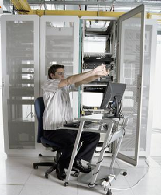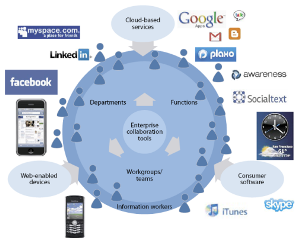IT 2.0 and its impact on business.
How do advanced technologies impact business?
You still don’t know? The world of IT is changing. In the wake of the upswing, social computer technologies, which we used to collectively call Web 2.0 technologies and which include various kinds of wikis, blogs, social networks, RSS and so on, are beginning to take root in the business world. A new project has appeared, whose name is Enterprise 2.0, and this is not at all an empty phrase. A conference on this topic will be held next week .

According to the website " News of web services and social networks", the project implies not just the introduction of new socially-oriented software into the boring and monotonous world of business, it is also proposed: modification of software that migrates from data centers to the network, development of staff mobility, the revival of" thin clients ", users who themselves will offer the use of the services they need, and much
more.System Administrator Version 2.0.
All this is just plans, but you have the opportunity to observe how gradually everything will change right before your eyes. Today they still continue to hire classic system administrators in the IT department, but very soon all this will be left in the past. Do not get it wrong: a good engineer is always in demand, but future IT leaders are those who will manage the business using a computer, who will work closely with the executive director in order to implement the chosen tactics and direction of the company with the help of information technologies - more there will not be those whom we used to call "sysadmins." You perfectly understand who I mean: this is a typical introvert, which is much more familiar to be constantly in front of a computer screen than to communicate with humanity. Human, which speaks abbreviations understandable only to him, which can perform any task by typing a few characters on the command line. Such people are an endangered species: at least it will soon take a lot of effort to find one in the office.
Today's system administrators will be replaced by real team fighters who have nothing to do with that mystical figure hiding behind a screen that appears only when something stops working.
Enterprise 2.0
No, the director will not come to you with news like: “Listen, I’ve been wondering if we should install Enterprise 2.0 software at home?” “These people will never say that, we all understand this perfectly, and it is unlikely that the situation will ever change.” A good IT specialist will always understand the negligent user and solve his problem, even if the user is not able to explain what he really needs. Most likely, we will hear something like this: “Newsletter via e-mail is outdated - in this regard, I would like to offer you a more convenient way to communicate with consumers of our services,” or “I think there is an easier way to keep up to date industry news ", - or -" Oh, how many versions of the same documents in our corporate network do not you think so? ” Today's system administrator will mumble something inarticulate, and an IT specialist 2. 0 knows what words to say: “Blog! RSS! Wiki! ”
And it’s not only the knowledge of terminology, today it’s up to you to choose the platform that you will recommend - whether you will increase your investment in SharePoint, which already includes a significant number of Web 2.0 tools, or whether you prefer a solution that takes into account your personal wishes. It is to these questions that a new generation of system administrators will have to answer. Yes, of course, they will have to have certain professional skills, but there is a huge difference between the fact that a person will simply be able to determine the maximum packet size in Windows, and that, in addition to this, he will be able to answer the question about which we spoke a little earlier.
Network services
IT 2.0 involves networking computers. If now the servers are located in special rooms and are protected by brand makers, then in the near future their place of deployment will change. For example, Microsoft is going to offer hosting services to users of many of its products, such as Exchange, BizTalk, SQL, SharePoint and so on. A test version of Microsoft's online services is already under development, and Bill Gates is talking about a future in which millions of servers will live in Microsoft data centers.
And this is only one of the possible development paths. Google is also closely monitoring the world of business. At first, there was just a simple offer for an easy-to-use, but fast-growing office web suite that could be easily installed at a minimal cost, then Google apps for your domain were added, and everything ended with the admin panel and security settings, Google Sites for teamwork and Google Web Security for Enterprise. They are well aware that the niche of web applications is now empty, and they can safely take it and create competition in the ever-evolving computer world. Microsoft and Google are world-famous companies, but they are just the tip of the iceberg of network computing. There are many more SaaS offers from Amazon Web Services.. The IT 2.0 user should know not only which software is best for the company in which he works, but also whether it will work if there is a brandmauer, in a network or in a network protected by a brandmauer.
Mobile staff.
Mobile staff will not be limited. With the ubiquity of broadband and the ever-growing number of employees from generation Y, mobility will be the norm, not the exception to the rule. Mobility, which we are accustomed to regard as the prerogative of staff who are constantly on the move, today will be available to almost everyone. Work at home will now be not a privilege, but a necessity.

IT departments will now have to choose those solutions that will meet the requirements of the new workforce - staff that almost always connects to the corporate network not at the workplace, but using insecure Wi-Fi in a local cafe or home wireless network. An IT specialist must find a way to provide users and install on their equipment the updates and patches necessary to protect corporate information, even if these users never use remote access. In addition, an IT professional should take care that, in the event of theft of, say, a corporate laptop that is clogged with important data, this information does not fall into the hands of intruders or competitors. Many companies are already using virtualization to solve this problem. The user gets access only to a kind of computer. All important information is stored on the server. Welcome back to the era of thin network computing.
Users themselves provide themselves with everything necessary.
This approach, duplicating Forrester research's Tech Populisim, targets a new tech-savvy user base. As soon as Generation X leaves and gives way to Generation Y, IT departments will have to deal with workers in whose life high technology is not the last place, and who are not afraid to be inventive in their work. Is the internal corporate website whipped up and contains a lot of mistakes? It doesn’t matter - they will create their own on Google Sites, Microsoft Live Workspace, Dasecamp or any other similar service that helps organize teamwork. Is the file too large to be emailed? It's okay, it will be posted on Box.net, Google Docs, Zoho, SkyDrive - any of the file storages with which it is usual to work. Those of IT professionals,

What to do to the poor system administrator? After all, he will not be able to completely turn off the Internet, no matter how hard he tries. Instead, an IT professional should be part of a common business - a large part of a common business - and foresee everything that employees might need. The whole trick is to develop, install on computers and make popular your solution, which is so easy to use among the staff, while this solution will protect corporate data, because now employees will no longer need to use third-party services.
Conclusion
All these changes will lead to the fact that future system administrators, even remotely, will not resemble today's. Huge demand will be enjoyed by those who, in addition to technical education, will have the skills to implement IT 2.0, but there are only a few such people. People who just maintain a computer network in the office, doing only its technical component, will remain overboard. Now they will move to data centers and, already there, will be engaged in the technical side of the issue. At the offices, there will appear sociable IT assistants living with common problems, who will organize the work of Enterprise 2.0.
Google bookmarks
You still don’t know? The world of IT is changing. In the wake of the upswing, social computer technologies, which we used to collectively call Web 2.0 technologies and which include various kinds of wikis, blogs, social networks, RSS and so on, are beginning to take root in the business world. A new project has appeared, whose name is Enterprise 2.0, and this is not at all an empty phrase. A conference on this topic will be held next week .

According to the website " News of web services and social networks", the project implies not just the introduction of new socially-oriented software into the boring and monotonous world of business, it is also proposed: modification of software that migrates from data centers to the network, development of staff mobility, the revival of" thin clients ", users who themselves will offer the use of the services they need, and much
more.System Administrator Version 2.0.
All this is just plans, but you have the opportunity to observe how gradually everything will change right before your eyes. Today they still continue to hire classic system administrators in the IT department, but very soon all this will be left in the past. Do not get it wrong: a good engineer is always in demand, but future IT leaders are those who will manage the business using a computer, who will work closely with the executive director in order to implement the chosen tactics and direction of the company with the help of information technologies - more there will not be those whom we used to call "sysadmins." You perfectly understand who I mean: this is a typical introvert, which is much more familiar to be constantly in front of a computer screen than to communicate with humanity. Human, which speaks abbreviations understandable only to him, which can perform any task by typing a few characters on the command line. Such people are an endangered species: at least it will soon take a lot of effort to find one in the office.
Today's system administrators will be replaced by real team fighters who have nothing to do with that mystical figure hiding behind a screen that appears only when something stops working.
Enterprise 2.0
No, the director will not come to you with news like: “Listen, I’ve been wondering if we should install Enterprise 2.0 software at home?” “These people will never say that, we all understand this perfectly, and it is unlikely that the situation will ever change.” A good IT specialist will always understand the negligent user and solve his problem, even if the user is not able to explain what he really needs. Most likely, we will hear something like this: “Newsletter via e-mail is outdated - in this regard, I would like to offer you a more convenient way to communicate with consumers of our services,” or “I think there is an easier way to keep up to date industry news ", - or -" Oh, how many versions of the same documents in our corporate network do not you think so? ” Today's system administrator will mumble something inarticulate, and an IT specialist 2. 0 knows what words to say: “Blog! RSS! Wiki! ”
And it’s not only the knowledge of terminology, today it’s up to you to choose the platform that you will recommend - whether you will increase your investment in SharePoint, which already includes a significant number of Web 2.0 tools, or whether you prefer a solution that takes into account your personal wishes. It is to these questions that a new generation of system administrators will have to answer. Yes, of course, they will have to have certain professional skills, but there is a huge difference between the fact that a person will simply be able to determine the maximum packet size in Windows, and that, in addition to this, he will be able to answer the question about which we spoke a little earlier.
Network services
IT 2.0 involves networking computers. If now the servers are located in special rooms and are protected by brand makers, then in the near future their place of deployment will change. For example, Microsoft is going to offer hosting services to users of many of its products, such as Exchange, BizTalk, SQL, SharePoint and so on. A test version of Microsoft's online services is already under development, and Bill Gates is talking about a future in which millions of servers will live in Microsoft data centers.
And this is only one of the possible development paths. Google is also closely monitoring the world of business. At first, there was just a simple offer for an easy-to-use, but fast-growing office web suite that could be easily installed at a minimal cost, then Google apps for your domain were added, and everything ended with the admin panel and security settings, Google Sites for teamwork and Google Web Security for Enterprise. They are well aware that the niche of web applications is now empty, and they can safely take it and create competition in the ever-evolving computer world. Microsoft and Google are world-famous companies, but they are just the tip of the iceberg of network computing. There are many more SaaS offers from Amazon Web Services.. The IT 2.0 user should know not only which software is best for the company in which he works, but also whether it will work if there is a brandmauer, in a network or in a network protected by a brandmauer.
Mobile staff.
Mobile staff will not be limited. With the ubiquity of broadband and the ever-growing number of employees from generation Y, mobility will be the norm, not the exception to the rule. Mobility, which we are accustomed to regard as the prerogative of staff who are constantly on the move, today will be available to almost everyone. Work at home will now be not a privilege, but a necessity.

IT departments will now have to choose those solutions that will meet the requirements of the new workforce - staff that almost always connects to the corporate network not at the workplace, but using insecure Wi-Fi in a local cafe or home wireless network. An IT specialist must find a way to provide users and install on their equipment the updates and patches necessary to protect corporate information, even if these users never use remote access. In addition, an IT professional should take care that, in the event of theft of, say, a corporate laptop that is clogged with important data, this information does not fall into the hands of intruders or competitors. Many companies are already using virtualization to solve this problem. The user gets access only to a kind of computer. All important information is stored on the server. Welcome back to the era of thin network computing.
Users themselves provide themselves with everything necessary.
This approach, duplicating Forrester research's Tech Populisim, targets a new tech-savvy user base. As soon as Generation X leaves and gives way to Generation Y, IT departments will have to deal with workers in whose life high technology is not the last place, and who are not afraid to be inventive in their work. Is the internal corporate website whipped up and contains a lot of mistakes? It doesn’t matter - they will create their own on Google Sites, Microsoft Live Workspace, Dasecamp or any other similar service that helps organize teamwork. Is the file too large to be emailed? It's okay, it will be posted on Box.net, Google Docs, Zoho, SkyDrive - any of the file storages with which it is usual to work. Those of IT professionals,

What to do to the poor system administrator? After all, he will not be able to completely turn off the Internet, no matter how hard he tries. Instead, an IT professional should be part of a common business - a large part of a common business - and foresee everything that employees might need. The whole trick is to develop, install on computers and make popular your solution, which is so easy to use among the staff, while this solution will protect corporate data, because now employees will no longer need to use third-party services.
Conclusion
All these changes will lead to the fact that future system administrators, even remotely, will not resemble today's. Huge demand will be enjoyed by those who, in addition to technical education, will have the skills to implement IT 2.0, but there are only a few such people. People who just maintain a computer network in the office, doing only its technical component, will remain overboard. Now they will move to data centers and, already there, will be engaged in the technical side of the issue. At the offices, there will appear sociable IT assistants living with common problems, who will organize the work of Enterprise 2.0.
Google bookmarks
